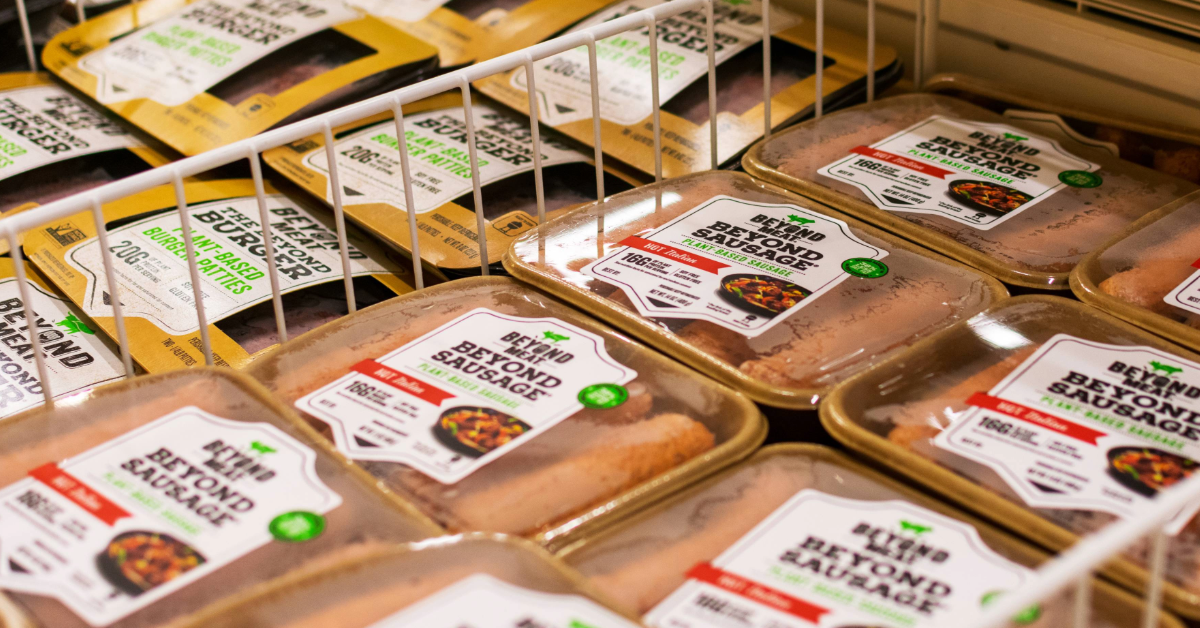
As the demand for plant-based products continues to grow, so too does the rate of advancement in this area. Although plant-based protein sources are generally more eco-friendly than their meat counterparts, there is still a need for “greener” proteins and production methods to help combat the rising concerns for the state of the planet. Inspired in part by their own experiences taking part in the Veganuary Workplace Challenge, as well as their place on the Sustainability Team, Sarah and Lauren explore some of the recent innovations in developing sustainable plant-based proteins.
How do vegans get enough protein?
Whenever Veganuary is mentioned, this question inevitably arises. However, meat-free diets are not exactly new; whether it be for religious, ethical, or environmental reasons, people have been adopting a “vegan” lifestyle (without the label) for centuries. As well as traditional plant-based protein options such as tofu and tempeh, in recent years we have seen an explosion of technological advances (and related IP-filings) which have greatly increased the variety and sources of plant-based protein on our supermarket shelves.
Experts agree that plant-based protein sources, including soy, generally have a lower ecological footprint than animal-based protein sources like beef. However, a large proportion of the currently available plant-based products are derived from a single crop, soy.
To meet the growing demand for plant-based products and increase their diversity, alternative sustainable sources of protein are also needed. We have talked previously about some of the exciting developments in this area including mycelium and microbe-produced proteins. Here are some other “green” alternative proteins, derived from plants and algae, that we might see on our plates in the future:
Peas
Already a commonplace addition to dinners in the UK, you may not realise that this vegetable is also relatively high in protein. However, as anyone who has tried a pea-based protein shake will know, it is hard to mask their taste when they are used as a plant-based protein source. Last year, a £1m Innovate UK project was announced which aims to develop “flavourless peas” as a reliable UK-grown protein source that can replace soya in human foods. Peas have several advantages compared with soya including being suited to the UK climate, environmentally friendly, and boosting soil health by fixing free nitrogen from the air. Interestingly, the project is following on from research in the 1990s into the genes responsible for maintaining pea freshness and flavour after picking. This also goes to show that you never know when research might turn out to have a surprising future application!
Amaranth
Amaranth is a grain, known for its nutritional richness - it is rich in protein, particularly the amino acid lysine, something which is often limited in other grains. It is considered a hardy plant that can thrive in various climates and is consumed regularly in Africa, Southeast Asia and South America, but is not currently utilised as a crop in the UK. Additionally, Amaranth contains significant amounts of dietary fiber, vitamins, and minerals.
London-based vertical farming company Vertical Future have partnered with the University of York and CHAP in a project which aims to develop amaranth as an meat alternative for the UK market using vertical farming. Amaranth is well-suited for vertical farming due to its compact root system which allows for efficient use of space. This approach could reduce both water and fertiliser use compared with traditional farming methods, and can reduce food miles if vertical farms are established close to where alternative meat products are produced and sold.
Lupin
Although relatively unknown as a food product in the UK, lupin (or lupini) beans have been traditionally eaten in the Mediterranean basin dating as far back as ancient Egypt. They are high in fibre, rich in vitamins and minerals and are considered a “complete protein” because they contain all nine essential amino acids that the human body cannot produce on its own. Lupins are increasingly being investigated as a sustainable protein source. They can be grown in nutrient poor soils due to their ability to fix Nitrogen and ‘unlock’ inaccessible Phosphorus due to associations with symbiotic bacteria.
Because of this, the lupin market has been rapidly expanding in recent years. For example, Eighth Day Foods have developed a ready-to-cook plant-based protein called “Lupreme®” which is made from lupin beans using their patented process of “Rapid Solid-State Fermentation” (RSSF).
Like many legumes, lupin seeds naturally accumulate bitter and toxic compounds called quinolizidine alkaloids (QAs). During traditional breeding programs, this means that sweeter, low QA lines are usually favoured. However, last summer, researchers identified the gene leading to sweetness in white lupin. The authors suggest that this research could assist breeding of new lupin varieties and could also have potential for domestication of other QA-containing legumes.
Canola
Many people will be familiar with the sight of large fields of bright yellow crops in the run up to summer. This is canola (or rapeseed), and whilst usually being grown to produce rapeseed oil, it can also be used for protein. In order to extract canola oil, the seeds from the plants are crushed. The remaining crushed seed mixture, known as canola meal, is protein-rich and already widely used as a protein source for livestock, poultry and fish feed. One major benefit is that the protein comes from what’s left behind after oil production. Efficiently repurposing a crop that is already grown and used is a fantastic way to reduce waste.
Unfortunately, in addition to the desired protein, conventional processing of canola results in canola meal that contains “antinutritional” factors such as glucosinolates, phenolics, phytates and a large amount of fibre. These can result in a bitter taste and also have negative effects on digestibility. In recent years, companies such as Botaneco have been developing new methods of extracting oil from canola that better preserve protein and remove antinutritional factors (albeit, for use in Salmon feed).
In terms of canola-based products which we might be eating ourselves in the future, Vertis CanolaPRO was launched at the end of 2022 and is marketed as providing a “meaty texture” in plant-based meat and fish alternatives, when used in combination with another ‘base’ protein such as pea.
(Micro)Algae
Another alternative protein source we’ve touched on before is algae. Algae contain chloroplasts and produce their own food through photosynthesis. They also have a high growth rate, low water consumption, and they do not require land for growth. Together, these factors mean they could be grown in a sustainable way at an industrial scale and could even improve the health of humans.
In fact, researchers at the University of Exeter recently showed that ingestion of either Spirulina or Chlorella (both types of microalgae) robustly stimulates myofibrillar protein synthesis in resting and exercised muscle tissue. Simply put, these microalgae are suitable for building and maintaining muscle, making them a strong candidate for an alternative protein.
However, there are some drawbacks which innovators are currently trying to overcome to allow microalgae to reach its potential in the alternative protein space. A major hurdle associated with the use of Chlorella in food products is the very high chlorophyll content, giving not only a distinctive dark green colour but also a strong (and somewhat unpleasant) taste and smell. To get around this, Algenuity have used established plant breeding methods to develop stable varieties of Chlorella with almost no chlorophyll which are “a neutral-tasting, highly nutritious and competitive, functional plant-based protein ingredient”. Although these variants are no longer photosynthetic due to their lack of chlorophyll, they can still be grown efficiently and sustainably in fermentation vessels using Biomass feedstock.
Conclusion
Here at Mewburn Ellis, we remain keen enthusiasts in the technologies shaping the future of food. Alternative sources of protein are an extremely important part of this, and also a key factor in the search for more sustainable food sources.
For those of us looking to minimise our ecological footprint with our food choices, there is plenty to look forward to as the innovations currently being developed in the lab start appearing on our supermarket shelves. Another factor which is likely to result in even more advancement in this area in the coming years is the recent decision of the UK Food Standards Agency board to reconsider its strict stance on precision-bred food and feed.
Spurred on by environmental concerns as well as the pressures of the growing population, the field of alternative proteins remains an exciting, expanding research area not only with regards to the innovations themselves, but also the related IP protection. We are looking forward to seeing how this field continues to develop in 2024 and beyond.
Authors
Sarah Harvey
Sarah is an associate patent attorney working as part of our life sciences team. She has a degree in Biological Sciences from Oxford University. She completed her PhD at Warwick University in plant pathology looking at how pathogen effectors manipulate the plant immune response. Sarah then worked as a post-doc in the Centre for Novel Agricultural Products at York University on plant responses to biotic stress.
Email: sarah.harvey@mewburn.com
Lauren is a trainee patent attorney working in our Life Sciences team. Lauren has a degree in Biochemistry from the University of York. She undertook a one year industry research placement in neurodegenerative diseases at the DZNE in Bonn. Her undergraduate research project focused on developing hydrogel biomaterials for stem cell growth. Following her degree, Lauren spent 18 months doing academic research at the Institute of Prion Diseases, specialising in whole-organ imaging.
Email: lauren.woolley@mewburn.com
Sign up to our newsletter: Forward - news, insights and features
Our people
Our IP specialists work at all stage of the IP life cycle and provide strategic advice about patent, trade mark and registered designs, as well as any IP-related disputes and legal and commercial requirements.
Our peopleContact Us
We have an easily-accessible office in central London, as well as a number of regional offices throughout the UK and an office in Munich, Germany. We’d love to hear from you, so please get in touch.
Get in touch


